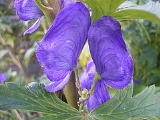
Aconitum carmichaelii
Encyclopedia
Aconitum carmichaelii is a flowering plant species native to East Asia
, particularly in China
and Japan
. It is commonly known as Chinese Aconite, Carmichael's Monkshood and Chinese Wolfsbane . It is known in Mandarin as Fu Zi (meaning daughter root, or lateral root) and as Wu Tou (meaning tuberous mother root, or root tuber).
ly in Dit Da Jow
liniment. If not prepared properly by a trained person, aconitum can be deadly when taken internally.
It is considered a medicinal herb in traditional Chinese medicine
and the root
is most commonly used to restore yang
and expel cold, for increasing blood flow, vasodilatation, hypertension, anti-inflammation, analgesic, and sedative and immunostimulation.
The of aconite in mice was 0.295 mg/kg SI, and that of the prepared decoction is 17.42 g/k. A lethal dose of aconitine is 3–4 mg.
East Asia
East Asia or Eastern Asia is a subregion of Asia that can be defined in either geographical or cultural terms...
, particularly in China
China
Chinese civilization may refer to:* China for more general discussion of the country.* Chinese culture* Greater China, the transnational community of ethnic Chinese.* History of China* Sinosphere, the area historically affected by Chinese culture...
and Japan
Japan
Japan is an island nation in East Asia. Located in the Pacific Ocean, it lies to the east of the Sea of Japan, China, North Korea, South Korea and Russia, stretching from the Sea of Okhotsk in the north to the East China Sea and Taiwan in the south...
. It is commonly known as Chinese Aconite, Carmichael's Monkshood and Chinese Wolfsbane . It is known in Mandarin as Fu Zi (meaning daughter root, or lateral root) and as Wu Tou (meaning tuberous mother root, or root tuber).
Biological effects
All parts of this plant are extremely toxic, and has historically been used as a poison on arrows. It is sometimes used topicalTopical
In medicine, a topical medication is applied to body surfaces such as the skin or mucous membranes such as the vagina, anus, throat, eyes and ears.Many topical medications are epicutaneous, meaning that they are applied directly to the skin...
ly in Dit Da Jow
Dit da jow
Dit Da Jow is a popular Chinese liniment sold to heal external damage such as bruises or sore muscles. There are several different recipes for Dit Da Jow, most of which are considered to be a "secret formula" passed down through oral and written history of Traditional Chinese Medicine, martial...
liniment. If not prepared properly by a trained person, aconitum can be deadly when taken internally.
It is considered a medicinal herb in traditional Chinese medicine
Traditional Chinese medicine
Traditional Chinese Medicine refers to a broad range of medicine practices sharing common theoretical concepts which have been developed in China and are based on a tradition of more than 2,000 years, including various forms of herbal medicine, acupuncture, massage , exercise , and dietary therapy...
and the root
Root
In vascular plants, the root is the organ of a plant that typically lies below the surface of the soil. This is not always the case, however, since a root can also be aerial or aerating . Furthermore, a stem normally occurring below ground is not exceptional either...
is most commonly used to restore yang
Yin and yang
In Asian philosophy, the concept of yin yang , which is often referred to in the West as "yin and yang", is used to describe how polar opposites or seemingly contrary forces are interconnected and interdependent in the natural world, and how they give rise to each other in turn. Opposites thus only...
and expel cold, for increasing blood flow, vasodilatation, hypertension, anti-inflammation, analgesic, and sedative and immunostimulation.
Chemical constituents
- AconitineAconitineAconitine is a highly poisonous alkaloid derived from various aconite species.-Uses:...
: Raw Fu Zi, 0.004%; prepared Fu Zi, trace/none. - Hypaconitine: Raw Fu Zi, 0.12%; prepared Fu Zi, 0.001%
- Mesaconitine: Raw Fu Zi, 0.033%; prepared Fu Zi, 0.001%
The of aconite in mice was 0.295 mg/kg SI, and that of the prepared decoction is 17.42 g/k. A lethal dose of aconitine is 3–4 mg.
Synonyms
- Aconitum chinense Paxton [= Aconitum carmichaelii var. truppelianum]
- Aconitum japonicum var. truppelianum Ulbr. [≡ Aconitum carmichaelii var. truppelianum]

